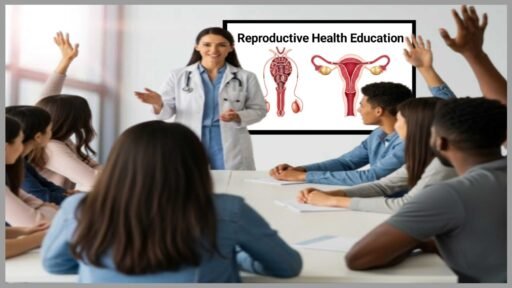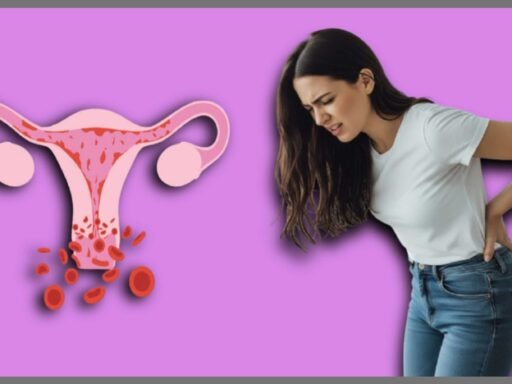Body Literacy for Teens
Adolescents need to be educated on their body as they navigate through adolescence, a complex process. Body literacy is the foundation for reproductive health education, which makes the youth sensitive to the information regarding their body development. In a new study in 2025, adolescents with good body literacy have better decision-making capacity for their sexual and reproductive health.
Body literacy is not just biological familiarity. It is an integrated understanding of how bodies work, grow, and relate at all stages of the life course. As a 2025 Journal of Adolescent Health article states, “Body literacy enables adolescents to recognize how gender and social norms influence their sexual and reproductive selves.” With this knowledge, adolescents are able to have healthier body relationships.
Digital technology has also revolutionized adolescent body literacy education. Interactive computer programs now offer young person-relevant information about puberty, reproduction, and body change. These sites use interactive formats like quizzes, videos, and personalized tracking features to make learning accessible and less confronting.
Parents play an enormous role in shaping body literacy. Open communication about body development lays the foundation for trust. Experts recommend starting such communication early and continuing it throughout adolescence. The American Academy of Pediatrics asserts firmly that “developing a healthy sexuality is a core developmental milestone” for adolescents.
Reproductive health education should cover body literacy in its entirety. Schools with evidence-based programs have fewer students with risk behavior. The programs entail conversations about hygiene habits, bodily autonomy, and emotional dimensions of body transformations.
Peer education is an effective body literacy approach. Since adolescents educate each other with correct information, it becomes okay to talk about reproductive health. This approach has worked especially among societies that do not have much to provide for formal reproductive health education.
Also Read: Family Planning: A Wise Choice!
Reproductive Cycle Awareness
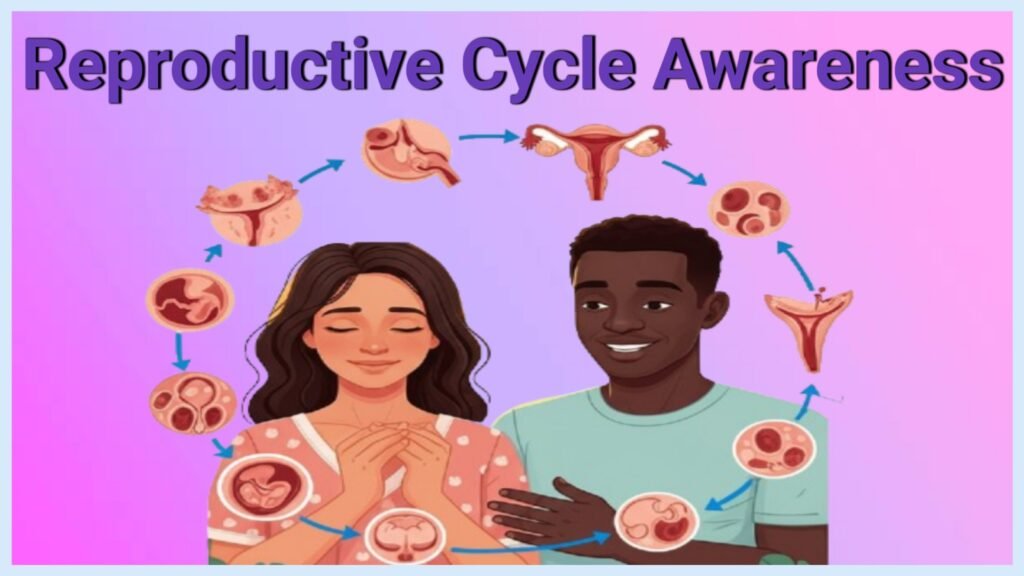
The awareness of the intricacy of the reproductive cycle is a key focus point of holistic reproductive health education. This knowledge is valuable in that it provides insight into fertility patterns, hormonal fluctuations, and overall reproductive well-being. Advances within recent years in cycle education have transformed the delivery and understanding of this valuable information.
Fertility awareness-based methods (FABMs) have been hailed as educational instruments and as methods of family planning. In a 2024 Family Medicine study, even short educational interventions on FABMs dramatically enhanced knowledge in medical students. This is reflective of the strength of specific educational interventions in enhancing awareness regarding reproductive cycles.
Modern cycle monitoring has transcended the old calendar approaches. New approaches utilize a range of biomarkers including basal body temperature, cervical fluid measurements, and hormonal indicators. The symptothermal approach, which considers all these observations, provides a more holistic understanding of the reproductive cycle.
Computer programs have revolutionized cycle tracking by offering personalized information, prediction, and learning content regarding cycle phases. The majority of programs have features to utilize in learning, so one can learn the biological significance of the observations.
Educational curricula increasingly recognize the worth of teaching people about reproductive cycle awareness at an early point. “Cycle literacy” is becoming a core component of comprehensive sex education. This is based upon learning about normal menstrual cycle variation and understanding when to seek out a doctor.
Reproductive health education should emphasize the interrelatedness of cycle awareness and overall health. The shift that happens in the cycle impacts not just fertility but also energy, mood, nutritional needs, and physical function. This integrated approach allows you to make good health decisions.
Cycle awareness education benefits individuals of both genders. Reproductive biology education benefits by fostering understanding, improving relationship communication, and creating more empathetic communities. Education on these subjects by all people fosters more open-minded reproductive health perspectives.
Also Read: Natural Family Planning: 6 Fertility Secrets
Sexual Health Resources
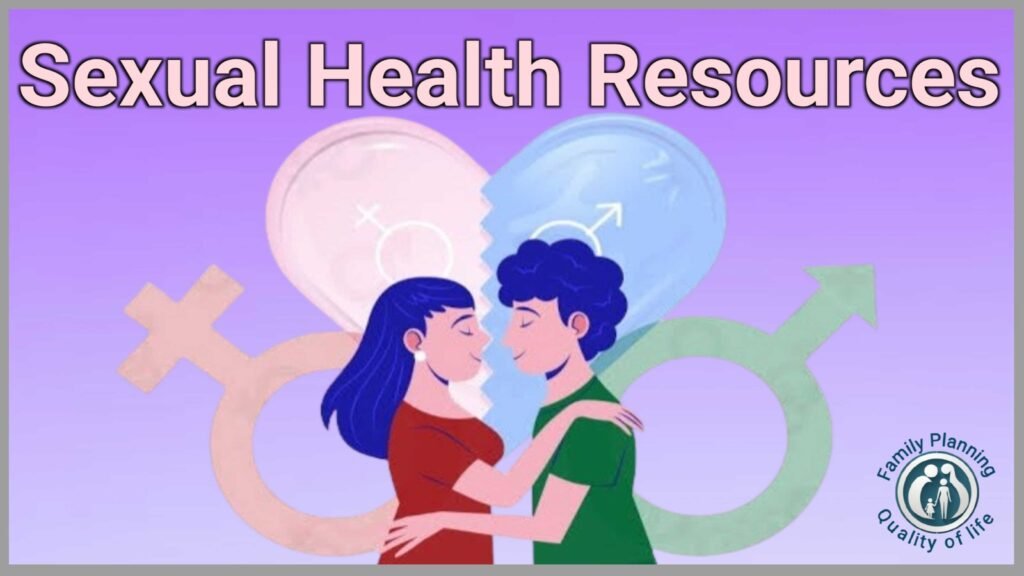
Making available good sexual health information remains at the forefront of overall reproductive health education. Modern approaches have evolved to address the different needs of today’s youth and young adults. Recent statistics for 2025 show that sexually transmitted diseases and unplanned pregnancy are on the decline in sexually healthy communities.
The internet is now the first point of contact for most adolescents. The Office of Population Affairs points out that “adolescent sexual and reproductive health” information must be available on the internet in a credible form. The internet sources offer anonymous access to credible information regarding contraception, safe sex, and relationship health.
Educational content has become more integrated and complete. The 2025 Guttmacher Institute report emphasizes that sexual health content must include biological, psychological, and relational dimensions of human sexuality. This holistic approach allows adolescents to build healthy attitudes toward relationships and intimacy.
Health care providers are focal sexual health resources. Adolescents and young adults want health care settings that provide non-judgmental, age-specific care, as a 2025 Adolescent Health Initiative survey showed. Education for providers now focuses on building rapport in talking about sensitive issues.
School-based programs are still a core part of reproductive health education. A Journal of Adolescent Health study demonstrates that school programs with a high content of health are linked to improved health outcomes. Programs function best when they complement what is achieved through communities and families.
Peer education networks become increasingly viable sexual health resources. Adolescents become more comfortable talking about sensitive topics to trained peers. Effective peer education models have been established by organizations like Advocates for Youth that provide accurate information while responding to social pressures.
Community-based groups offer valuable resources, particularly to groups that are under-resourced. They provide services ranging from education to testing to birth control access. They can fill gaps in reproductive health education that otherwise remain unfilled.
Also Read: A Comprehensive Guide to Contraception Methods (2025)
Reproductive Rights Advocacy
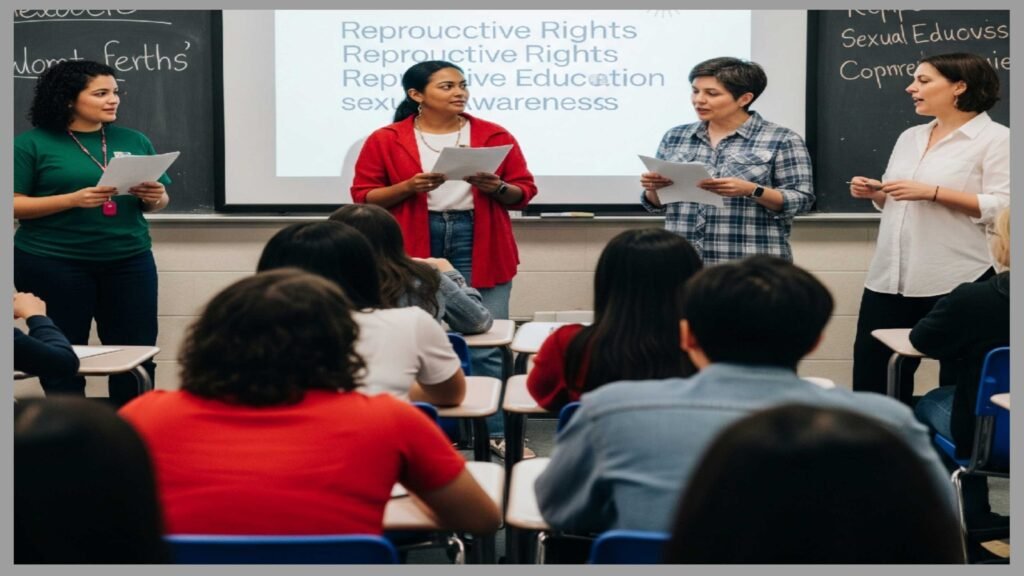
Encouraging reproductive rights is an essential part of comprehensive reproductive health education. Understanding these rights provides people with the means to make educated decisions about their future and lives. Advances in 2025 presented both progress and ongoing challenges to this important area.
Education on reproductive rights varies greatly by region. The Center for Reproductive Rights suggests that legal protections and limitations on reproductive health care directly affect health outcomes and that reproductive health education should involve clear information regarding rights that are available and how to access them.
Young adults are increasingly involved in advocacy campaigns. According to a 2025 survey, 70% of young adults view reproductive rights information as part of essential health education. The generation is aware of the connection between rights awareness and ensuring access to proper care. Online activism revolutionized advocacy work. Social media campaigns work well in raising awareness on issues of reproductive rights and rallying people’s support. Online forums are also a source of education, where people learn more about intricate legal and policy developments in reproductive healthcare.
Community-based organizations play an important role in the dissemination of reproductive rights education. They offer information about local law, services provided, and support networks. Grass-root strategies employed by these organizations ensure that otherwise marginalized populations are reached in terms of accessing information about their rights.
Health care providers increasingly recognize their part in rights education. Professional organizations now recommend that reproductive rights become standard parts of patient education. Placement ensures that people are thoroughly informed about their health care choices and associated legal protection.
Educating about reproductive health must address how rights intersect with other elements of identity. Race, class, and geography all play a large part in determining access to reproductive services. By learning about the intersections, the advocates can battle for more equitable systems for everyone.
Challenges persist with reproductive rights advocacy. Progress towards attaining global access to full reproductive education is being thwarted in most regions. However, forging coalitions among stakeholders persists in propelling educational processes towards rights consciousness.
Also Read: Fertility Tracking: Your Path to Success Pregnancy (2025)
Menstrual Health Education
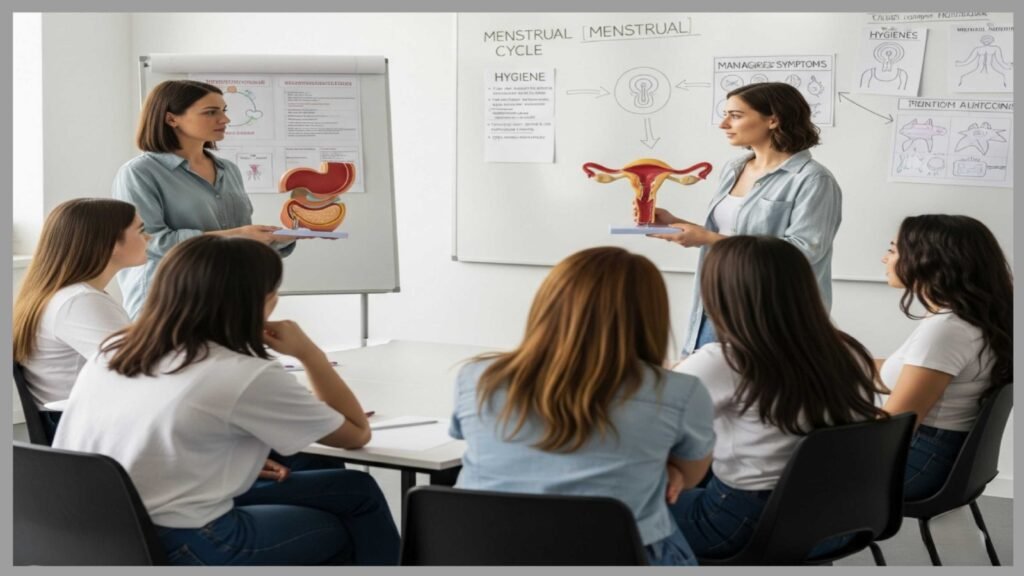
Systematic menstruation education is part of reproductive health education. Contemporary strategies acknowledge the need to de-stigmatize menstruation while offering practical information on menstrual care. In 2025, new developments changed the way this fundamental area of study is taught.
Menstruation education has been revolutionized with digital technology. Technology is leading the way in “moving women’s rights forward and eradicating the stigma of menstruation,” according to a January 2025 report by Tech to the Rescue. It is now possible to have period tracking with accompanying educational content on normal changes and symptoms in mobile apps.
Educational programs today focus on environmental sustainability. Programs today include information about sustainable menstrual products alongside traditional products. The approach aids in growing environmental awareness among youth as well as increasing their knowledge of available menstrual management systems.
Better menstrual education has been made available in schools. Research shows that early education prevents the acquisition of negative attitudes towards menstruation. These interventions are beneficial for all students irrespective of gender, raising awareness and reducing stigma in society.
Specialized technology has arisen to offer culturally relevant menstrual health education. In January 2025, scientists launched MenstLLaMA, “a specialized LLM that has been developed for the Indian context with the intent of delivering menstrual health training empathetically, helpfully, and correctly.” This technology demonstrates the potential of technology to meet particular cultural demands in reproductive health training.
Psychological factors of menstruation are accorded greater importance in education today. Premenstrual mood swings are one of the topics that are covered in classes, and adolescents are taught to understand the emotional aspects of their cycles. This integrated approach adds to overall well-being in the menstrual cycle.
Community-based interventions are effective in reaching groups that have poor access to education. Interventions employ peer educators to spread accurate information in culturally appropriate ways. Their efficacy demonstrates the worth of diverse approaches to menstrual health education.
Schools and workplaces increasingly adopt menstrual-friendly policies through education-led initiatives. Menstrual-friendly policies have the support and resources of menstruators. Education on the same makes everyone’s space more inclusive.
Also Read: Preconception Health: Essential Guide to Pregnancy Prep (2025)
LGBTQ+ Inclusive Family Planning
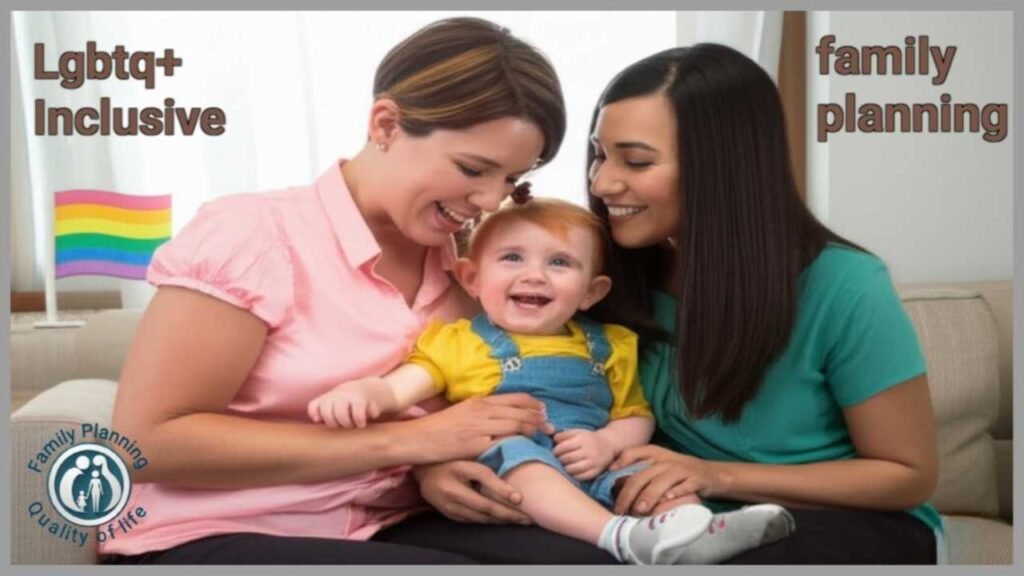
Reproductive health education needs to be inclusive in how it addresses the special needs of LGBTQ+ individuals and families. Practices today recognize the diversity of individuals creating families and experiencing reproductive health. Materials developed for 2025 show better work in creating truly inclusive teaching materials.
Comprehensive learning materials now accept different family structures. Organizations such as Family Equality offer schools multimedia materials—books, curriculum, and computer aids—to foster tolerance and respect among student populations.” These materials allow all students to accept the validity of alternative family structures.
Health care providers receive specialized training in LGBTQ+ affirming care. The National LGBTQIA+ Health Education Center has resources that are specifically designed for health care providers. Training is provided for family planning discussions that are sensitive and relevant to all patients irrespective of sexual orientation or gender identity.
Both websites have developed specific information on LGBTQ+ family planning. This information includes precise topics like donor selection, surrogacy, and adoption. By providing accurate information on these pathways, educational content enables informed decision-making.
Curricula of schools now increasingly incorporate LGBTQ+ perspectives when teaching reproductive health. According to Advocates for Youth, quality curricula offer “K-12 educators with LGBTQ-inclusive curricula, training, and mentorship.” Through this, all the students are given appropriate knowledge when it comes to reproductive health.
Local advocacy groups provide targeted assistance to LGBTQ+ individuals who are going through family-building processes. These groups provide information materials as well as hands-on assistance in getting through complex systems. Their expertise helps to address the unique problems LGBTQ+ individuals may encounter in forming families.
In reproductive health education, language used is increasingly becoming inclusive. Modern resources adopt language that is inclusive of bodies, identities, and relationships of every type. This change in language is a significant step towards complete inclusive reproductive health education.
Educational materials increasingly address legal concerns unique to LGBTQ+ family planning. These materials give families the facts regarding legal laws regarding parental rights, donor agreements, and adoption procedures. This knowledge empowers prospective parents with assurance to wade through intricate legal frameworks.
Reproductive health education is the key to decision-making throughout life. By promoting body literacy, cycle awareness, sexual health knowledge, reproductive rights awareness, menstrual health education, and LGBTQ+ inclusive family planning, comprehensive programs emphasize individual and community well-being. New strategies focus on accessibility, inclusivity, and evidence-based knowledge to enable everyone to have access to the information they require for the best reproductive health.

